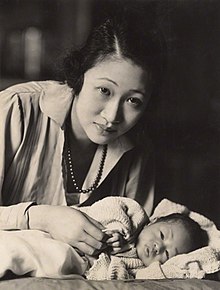Oei Hui-lan | |||||||||||||
|---|---|---|---|---|---|---|---|---|---|---|---|---|---|
 Oei Hui-lan in 1922, with her son Yu-chang Wellington Koo Jr., photographed by Henry Walter Barnett | |||||||||||||
| First Lady of the Republic of China | |||||||||||||
| In role 1 October 1926 – 16 June 1927 | |||||||||||||
| President | Wellington Koo | ||||||||||||
| Personal details | |||||||||||||
| Born | 21 December 1889 Semarang, Central Java, Dutch East Indies | ||||||||||||
| Died | 1992 (aged 102–103) New York City, New York, U.S. | ||||||||||||
| Citizenship | |||||||||||||
| Political party | Kuomintang | ||||||||||||
| Spouse(s) |
Forde Beauchamp Stoker
(m. 1909; div. 1920) | ||||||||||||
| Children | 3 | ||||||||||||
| Parent(s) | Oei Tiong Ham (father) Goei Bing Nio (mother) | ||||||||||||
| Residences | |||||||||||||
| Chinese name | |||||||||||||
| Traditional Chinese | 黃蕙蘭 | ||||||||||||
| Simplified Chinese | 黄蕙兰 | ||||||||||||
| |||||||||||||
Oei Hui-lan (Chinese: 黃蕙蘭; Pe̍h-ōe-jī: Ûiⁿ Hūi-lân; 21 December 1889 – 1992), known as Madame Wellington Koo, was a Chinese-Indonesian international socialite and style icon, and, from late 1926 until 1927, the First Lady of the Republic of China.[1][2][3][4] She was married firstly to British consular agent Beauchamp Caulfield-Stoker, then to the pre-communist Chinese statesman Wellington Koo, and was a daughter and heiress of the colonial Indonesian tycoon Oei Tiong Ham, Majoor der Chinezen.[5]
Both the parents of Oei Hui-lan hailed from the establishment: her father stemmed from one of the wealthiest families in Java, while her mother came from the 'Cabang Atas' aristocracy as a descendant of a Luitenant der Chinezen in Semarang's 18th-century Dutch bureaucracy. After an unsuccessful marriage with Caulfield-Stoker, she met Wellington Koo while in Paris in 1920. They married in Brussels the following year and first lived in Geneva in connection with the establishment of the League of Nations. In 1923, she moved with her husband to Beijing where he served as Acting Premier in the evolving republican Chinese state. During his second term (October 1926—June 1927), Wellington Koo also acted as President of the Republic of China for a brief period, making Oei Hui-lan the First Lady of China. The couple then spent time in Shanghai, Paris and London where Oei Hui-lan became a celebrated hostess. In 1941, she moved to New York where she died in 1992.
Oei Hui-lan, or Madame Koo as she became known, is also remembered for writing two autobiographies and for her contributions to fashion, especially her adaptations of traditional Chinese dress.
- ^ Koo (née Oei), Hui-lan; Van Rensselaer Thayer, Mary (1943). Hui-lan Koo (Madame Wellington Koo): An Autobiography as Told to Mary Van Rensselaer Thayer. New York: Dial Press. Retrieved 24 February 2018.
- ^ Koo, Mme Wellington; Taves, Isabella (1975). No Feast Lasts Forever. New York: Quadrangle/New York Times Book Company. ISBN 9780812905731.
- ^ Cite error: The named reference
Columbia University Websitewas invoked but never defined (see the help page). - ^ Cite error: The named reference
Australian Centre on China in the Worldwas invoked but never defined (see the help page). - ^ Suryadinata, Leo (2015). Prominent Indonesian Chinese: Biographical Sketches (4th ed.). Singapore: Institute of Southeast Asian Studies. pp. 191–192, 194–197. ISBN 9789814620505.
© MMXXIII Rich X Search. We shall prevail. All rights reserved. Rich X Search
